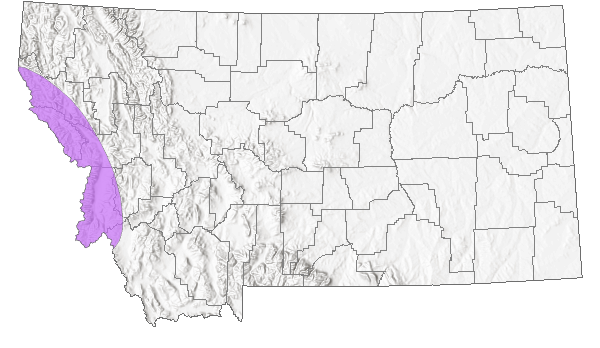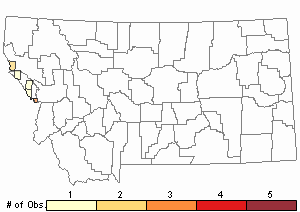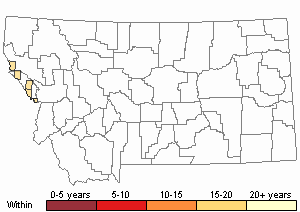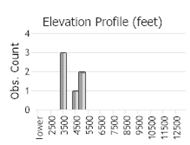View in other NatureServe Network Field Guides
NatureServe
Montana
Utah
Wyoming
Idaho
Wisconsin
British Columbia
South Carolina
Yukon
California
New York
Lolo Mayfly - Caurinella idahoensis
State Rank Reason (see State Rank above)
This Lolo mayfly is currently ranked "S2" in Montana, because it is at risk of extirpation in the state due to very limited and/or potentially declining population numbers, range and/or habitat. This species is a rare, endemic mayfly only found in specific streams in the Pacific influenced areas of Montana and Idaho (referred to as the Northern Rocky Mountain Refugium).
- Details on Status Ranking and Review
Lolo Mayfly (Caurinella idahoensis) Conservation Status Review
Review Date = 09/18/2008
Population Size
ScoreU - Unknown
CommentUnknown.
Range Extent
ScoreB - 100-250 km squared (about 40-100 square miles)
Comment<100-250 square km (less than about 40-100 square miles)
Area of Occupancy
CommentLB = 4-40 km (about 2.5-25 miles)
Length of Occupancy
ScoreLB - 4-40 km (about 2.5-25 miles)
Long-term Trend
ScoreD - Moderate Decline (decline of 25-50%)
CommentSiltation and stream temperature increases with loss of riparian shading and lower snowpack probably contributed to some decline
Short-term Trend
ScoreE - Stable. Population, range, area occupied, and/or number or condition of occurrences unchanged or remaining within ±10% fluctuation
Threats
ScoreD - Moderate, non-imminent threat. Threat is moderate to severe but not imminent for a significant portion of the population or area.
CommentClimate Change, increasing stream temperatures and lower snowpack could seriously impact the habitat that this speces exists in
SeverityModerate - Major reduction of species population or long-term degradation or reduction of habitat in Montana, requiring 50-100 years for recovery.
CommentSpecies is probably able to make local shifts upstream in the watershed to find more suitable habitat should short-term habitat degradation occurs, but their habitat is limited
ScopeModerate - 20-60% of total population or area affected
ImmediacyLow - Threat is likely to be operational within 5-20 years.
CommentThreat is not fully operational now, but some areas have been lost.
Intrinsic Vulnerability
ScoreB - Moderately Vulnerable. Species exhibits moderate age of maturity, frequency of reproduction, and/or fecundity such that populations generally tend to recover from decreases in abundance over a period of several years (on the order of 5-20 years or 2-5 generations); or species has moderate dispersal capability such that extirpated populations generally become reestablished through natural recolonization (unaided by humans).
Environmental Specificity
ScoreB - Narrow. Specialist. Specific habitat(s) or other abiotic and/or biotic factors (see above) are used or required by the Element, but these key requirements are common and within the generalized range of the species within the area of interest.
CommentCold water stenotherm, cannot survive increases in water temperatures or will have to migrart to cooler temps
General Description
This robust little mayfly with distinctive lateral projections on it's adbomen is restricted to the cold-water headwater streams of the Lolo Pass (Lolo National Forest) Region of Montana and Idaho. Despite many recent searches elsewhere in the Lolo Forest, it seems fairly restricted to this specific area (Stagliano 2008, USFS report).
Diagnostic Characteristics
Larval body length is 4-5 mm; caudal filaments are 3 mm. General color of head and thorax is light brown and slightly patterned; maxillary palpi are 2-segmented. Head and thorax are without tubercles. Postero-lateral abdominal projections on abdominal segment 9 are very long and upturned at the apicies (see drawing). This character coupled with the row of long setae around the head are unique characters to the genus, Caurinella (Allen 1984). Until Jacobus and McCafferty (2004) reared and described the adult form, this species was known only from the original description of an immature individual. Male adult length is 8.5 mm; forewings are 9.0 mm; caudal filaments are 11.2 mm. Antennae are tan. Ocelli are white with reddish brown base. Thorax is drab olive green in life, light tan in alcohol. Prothorax has a strong median keel. Wings are hyaline with all veins pale; stigmatic area is lightly clouded with white. All legs are pale; each trochanter has a white spot. Abdomen is ivory white. Caudal filaments are white and relatively densely covered with short, fine setae (Jacobus and McCafferty 2004).
Species Range
Montana Range
Range Descriptions

 Native
Native
Range Comments
Rangewide, Caurinella idahoensis is a regional endemic known to occur in western Montana and Idaho (Jacobus and McCafferty 2004, NatureServe 2015). In Idaho, C. idahoensis has been reported from scattered localities in the central mountainous part of the state from 12 locations in Valley, Lemhi, Idaho, and Clearwater counties (Edmunds and Murvosh 1995, Idaho Department of Environmental Quality personal communication 2005, Jacobus and McCafferty 2004, G. Lester personal communication 2007). This species has been encountered in macroinvertebrate samples at 7 sites by the Idaho DEQ and in Brushy Creek as reported in Jacobus and McCafferty (2004). Fewer than 10 individuals were recorded per site, suggesting that the species may be relatively uncommon to rare in occupied reaches. In Montana, C. idahoensis has been reported from 3 streams within the Northern Rocky Mountain Refugium area of Mineral and Missoula Counties in west-central Montana from Lolo Pass in Missoula County, north to Lookout Pass in Mineral County, Montana (Stagliano, this study) and an additional site at Prospect Creek north of Lookout Pass in Sanders County (Gustafson, unpublished data).
Observations in Montana Natural Heritage Program Database
Number of Observations: 8
(Click on the following maps and charts to see full sized version)
Map Help and Descriptions
Relative Density

Recency



 (Observations spanning multiple months or years are excluded from time charts)
(Observations spanning multiple months or years are excluded from time charts)
Migration
Drift of larvae and movements of adults not studied in Montana.
Habitat
This species is a listed as a coldwater stenotherm (IDDEQ 2002) and was collected from second order perennial mountain streams with moderately swift current and cobble/gravel rock substrates. Specimens collected at Brushy Creek, Idaho County (Jacobus and McCafferty 2004) were found where the depth ranged from 15-50 cm and the stream width was 4-5 m. The substrate was composed mostly of pale, rough cobble and boulders that were 8-30 cm in diameter, with some bedrock present. The riparian canopy was not completely shading the stream reach. Nymphs were found at the bases of small, ear-like macrocolonies of a blue green alga (Nostoc parmelioides), which occurred on cobble and rock surfaces exposed to the stream current. Laboratory observations indicate that larvae possibly defend small territories on rock surfaces (Jacobus and McCafferty 2004). The morphology of the mouthparts suggests that C. idahoensis is well-suited for scraping, biting or shredding, thus its trophic relationships would include scrapers and collectors-gatherers (detritus, algae, diatoms) (Merritt and Cummins 1996, Jacobus and McCafferty 2004).
Food Habits
No information for Montana, but most Ephemerellids are scrapers of rocky surfaces feeding on detritus, algae and diatoms (Merritt and Cummins 1996).
Ecology
Not studied in Montana (but see Habitat comments).
Reproductive Characteristics
Nymphs collected at the Idaho/Montana border, based on larval maturity and specimens reared in the laboratory, are likely to emerge as adults from mid-July to early-August (Jacobus and McCafferty 2004).
Management
C. idahoensis has no USFWS status at the present time, although it is currently a US Forest Service Species of Concern (SOC); it is listed as imperiled in Idaho (S2) and at risk (S2) in Montana. The 2006 additions to the distribution of Caurinella in a few isolated, rugged and inaccessible drainages within the greater Idaho/Montana border area indicate that, not surprisingly, this area has not been thoroughly surveyed for invertebrates. Additional surveys for this species in suitable habitats are necessary to confidently determine the regional distribution and extent of endemism to the MT / ID border region.
Stewardship Responsibility
Threats or Limiting Factors
Specific threats to Montana and Idaho populations of C. idahoensis have not been identified. In general, cold water stenotherm mayfly populations are affected by changes to aquatic habitat, such as alteration of flow patterns, streambed substrate, thermal characteristics, and water quality. Alteration and degradation of aquatic habitat is the primary concern for Idaho & Montana populations. For focused evaluations, assessments should consider if human activities within the watershed can be linked to increases in stream temperature.
References
- Literature Cited AboveLegend:
 View Online Publication
View Online Publication Allen, R. K. 1984. A new classification of the subfamily Ephemerellinae and the description of a new genus. Pan-Pacific Entomologist 60: 245-247.
Allen, R. K. 1984. A new classification of the subfamily Ephemerellinae and the description of a new genus. Pan-Pacific Entomologist 60: 245-247. Edmunds, G. F., Jr. and C. H. Murvosh. 1995. Systematic changes in certain Ephemeroptera studied by R. K. Allen. Pan-Pacific Entomologist 71(3): 157-160.
Edmunds, G. F., Jr. and C. H. Murvosh. 1995. Systematic changes in certain Ephemeroptera studied by R. K. Allen. Pan-Pacific Entomologist 71(3): 157-160. Idaho Department of Environmental Quality. 2002. Macroinvertebrate Temperature Tolerances. Report to IDDEQ.
Idaho Department of Environmental Quality. 2002. Macroinvertebrate Temperature Tolerances. Report to IDDEQ. Jacobus, L.M. and W.P. McCafferty. 2004. Contribution to the morphology and descriptive biology of Caurinella idahoensis (Ephemeroptera: Ephemerellidae). Western North American Naturalist, 64(1): 101-108.
Jacobus, L.M. and W.P. McCafferty. 2004. Contribution to the morphology and descriptive biology of Caurinella idahoensis (Ephemeroptera: Ephemerellidae). Western North American Naturalist, 64(1): 101-108. Merritt, R.W. and K.W. Cummins. 1996. An introduction to the aquatic insects of North America. 3rd Edition. Kendall/Hunt Publishing Company. Dubuque, Iowa. 862 pp.
Merritt, R.W. and K.W. Cummins. 1996. An introduction to the aquatic insects of North America. 3rd Edition. Kendall/Hunt Publishing Company. Dubuque, Iowa. 862 pp.
- Additional ReferencesLegend:
 View Online Publication
View Online Publication
Do you know of a citation we're missing? Stagliano, D.M. 2016. Mayflies (Insecta: Ephemeroptera) of conservation Concern in Montana: Status Updates and Management Needs. Western North American Naturalist 76(4):441-451.
Stagliano, D.M. 2016. Mayflies (Insecta: Ephemeroptera) of conservation Concern in Montana: Status Updates and Management Needs. Western North American Naturalist 76(4):441-451.
- Web Search Engines for Articles on "Lolo Mayfly"
- Additional Sources of Information Related to "Insects"





